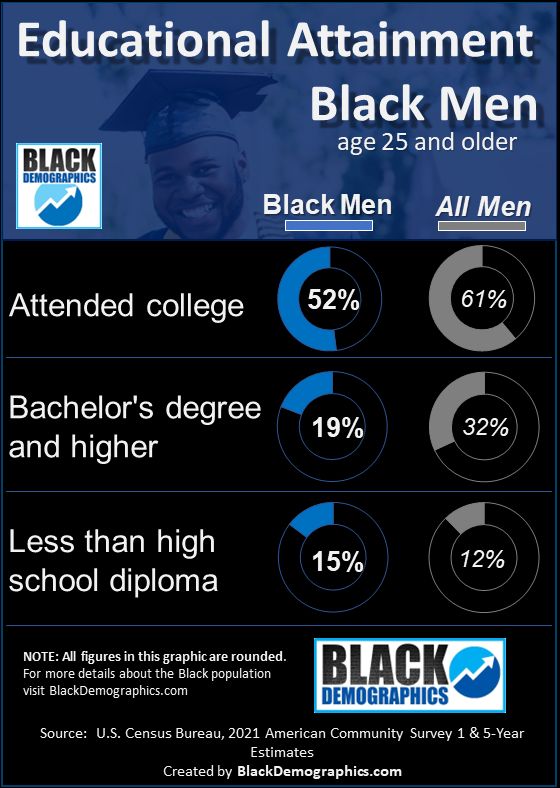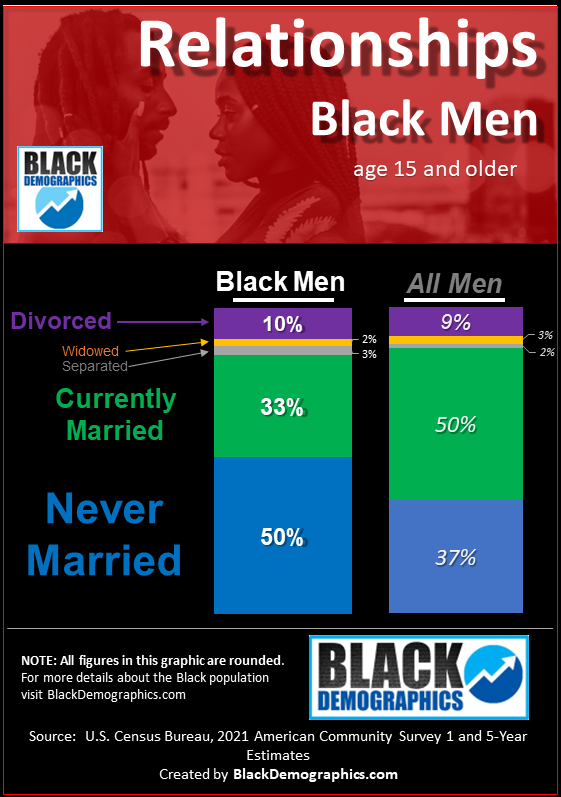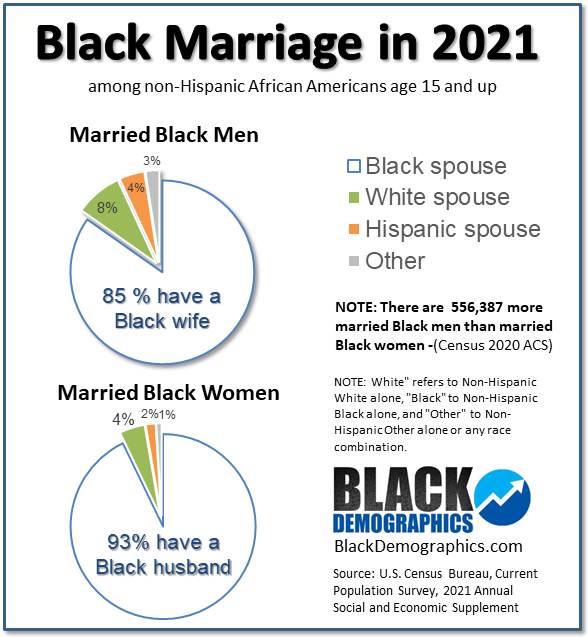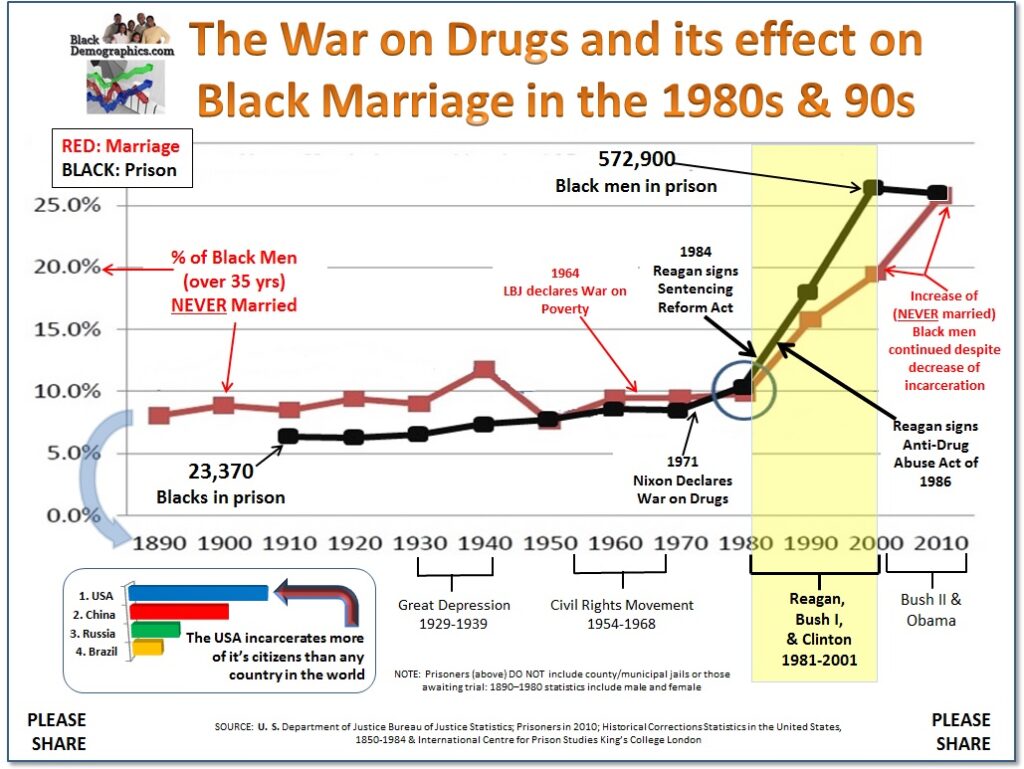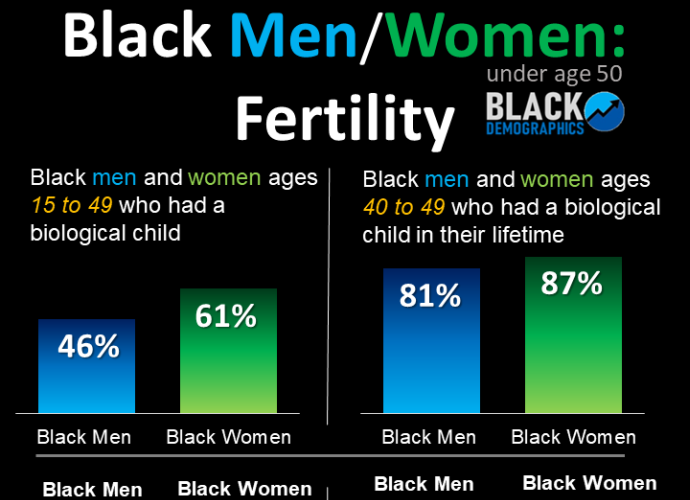Black Men: Statistics
POPULATION
According to the US Census Bureau American Community Survey (2021) the Black male population who consider themselves ‘Black Alone’ (and not combined with any other race) in the United States was 20 Million in 2021. This is 48% of the total Black Alone population compared to Black females who make up 52% of the Black population..
The median age of Black males (35) was two years older than it was in 2018 (33) but still younger than all U.S. males which increased during the same time period from 37 to 39 years old (rounded).
However, when looking at a breakdown of age, Black male children under 18 years old are at the same percentage as ‘all male children’ (51%). The percent of the population who are males declines much quicker for Black males as they get older due to a higher mortality rate than males on average (see above table). This considering that men of all races and ethnicities have a shorter lifespan than women.
EDUCATION
By 2021 about 52% of Black men (compared to 61% of all men) 25 and older had been to college which was an increase from 50% in 2018. The percentage of Black men with a bachelor’s degree or higher has increased from 19% to 22% during the same time period (compared to 34% of all men who had a bachelor’s degree and higher in 2021.
The second biggest disparity between Black men and ‘all men’ in America is with those who have a bachelor’s degree. Only 14% of Black men had a bachelor’s degree compared to 21% of ‘all men’. Second is the number of Black men who finished high school but did not pursue higher education, 35% compared to 28% of ‘all men’.
The percentage of Black men with an associates degree (8%) was equal to that of ‘all men’ (8%) in America (see above table). Only 13% of Black men over 25 did not complete high school down from 15% in 2018. This is still higher than the percent for men of all races and ethnic groups together (11%) but only by two percentage points. More about Education…
EMPLOYMENT
African American males ages 16 to 64 had a lower participation rate in the labor force (69%) compared to ‘all males’ (79%) (see below table). Labor force participation refers to the percent of men who were either working or looking for work. Males not in the labor force include those who may be full time students, disabled, and others who are not looking or gave up looking for employment for other reasons.
About 37% of African American males worked full time compared to 47% of all males. In 2021 full time Black males had median earnings of $46,065 compared to $60,428 for ‘all men’ (below table). Of Black men ages 16 to 64 years old, 41% had no earnings in 2021 which was higher than the 30% of ‘all men’ with no earnings in the same age group.
Compared to ‘all men’ in the United States Black men who worked were less likely to work in occupations that may be considered white collar and were more likely to hold blue collar or service jobs. Only 41% of working Black men held so-called white collar jobs compared to 53% of ‘all men’ (above chart). For the purpose of the above table white collar occupations include but are not limited to jobs in management, business, computers, office, legal, education, etc.
Blue collar occupations which were held by 21% of working Black men (compared to 13% of all American men) which include employment in construction, maintenance and repair, installation, production, transportation, etc. Service occupations include healthcare support, protective service, food preparation and serving, etc.
Cities Where Black Men with Jobs Outnumber Black Women
Nationwide there are 93 Black men with full-time jobs for every 100 Black women with full-time jobs but that number can vary greatly depending on the location. (See Chart Below)
For example 1. San Diego (167%) has 167 full-time working Black men for every 100 full-time working Black women, while 49. St. Louis (78%) only has 78 full-time working Black men for every 100 full-time working Black women. SEE LIST OF ALL CITIES
RELATIONSHIPS
The percentages of Black men who are married and who have never been married are almost the exact opposite of those percentages for ‘all men’ in America (left chart). Although 50% of Black men have NEVER been married (down two points from 2018) 50% of ‘all men’ are CURRENTLY married. Only 33% of Black men are CURRENTLY married while only 37% of ‘all men’ in America have NEVER been married. Black men are just as likely to be separated, widowed, or divorced from their spouses compared to all men.
While Black men marry white women at twice the rate that Black women marry White men, in 2021 only 15% percent of married Black men were married to non-Black women which is unchanged from 2017 but up from 11% in 2010 and 8% in 2000. About 8% of married Black men were married to White women in 2021 and 4% were married to Hispanic women. More about Marriage…
In 2012 The U.S Census Bureau released a report that studied the history of marriage in the United States. They discovered some startling statistics when calculating marriage by race. They found that African Americans age 35 and older were more likely to be married than White Americans from 1890 until sometime around the 1960s. Not only did they swap places during the 60s but in 1980 the number of NEVER married African Americans began a staggering climb from about 10% to more than 25% by 2010 while the percentage remained just over 10% for White men through 2000. The chart above was included in the report only the heading has been altered by BlackDemographics.com to outline these findings.
The above chart illustrates how closely the marriage graph for Black men aligns with the incarceration numbers which also experienced an abnormal climb beginning in 1980. This does not prove causation however it shows that they are related due to the assumption that men in prison are less likely to marry.
NOTE: Data Below is from 2013 or before. It has yet to be updated.
OTHER CHARACTERISTICS
In 2013 about 6% of working-age (18-64yrs old) Black men were in state or federal prison, or in a municipal jail (see chart right). This was three times higher than the 2% of ‘all men’ in the same age group. What’s even more concerning is that approximately 34%* of all working-age Black men who were not incarcerated were ex-offenders compared to 12% of ‘all men’ which means they have at one point in their lives been convicted of a felony. This data coincides with the increased absence of Black men in the labor force because ex-offenders are prevented from obtaining a large percentage of occupations either by law and are often legally discriminated against by private employers.
*IMPORTANT NOTE: Ex-offender calculations have a larger range of uncertainty than most due to the range of factors and degree of variance of each sources methodology. Recidivism (repeat offending), unknown death rates, and difference in state reporting methods are some of the factors contributing to this uncertainty. Sources from 1998-2008)
In 2013 Fourteen percent of working-age Black men were veterans of U.S. military which was just slightly lower than all male veterans (15%). A larger percentage of working age Black men were considered disabled (16%) compared to ‘all men’ (11%).
Black father statistics that were here are being reviewed to ensure accuracy. Please review to our Terms of Service for questions regarding accuracy of data presented on this site.




